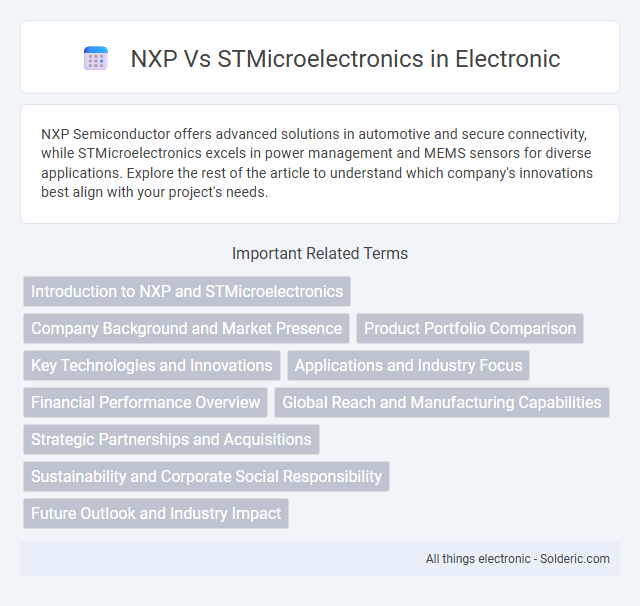NXP Semiconductor offers advanced solutions in automotive and secure connectivity, while STMicroelectronics excels in power management and MEMS sensors for diverse applications. Explore the rest of the article to understand which company's innovations best align with your project's needs.
Comparison Table
| Feature | NXP Semiconductors | STMicroelectronics |
|---|---|---|
| Headquarters | San Jose, California, USA | Geneva, Switzerland |
| Founded | 2006 (spun off from Philips) | 1987 (merger of SGS Microelettronica and Thomson Semiconducteurs) |
| Core Markets | Automotive, Industrial, IoT, Mobile, Security | Automotive, Industrial, Consumer Electronics, IoT, Imaging |
| Key Products | Microcontrollers, Automotive ICs, Secure Elements, RF Solutions | Microcontrollers, Sensors, Power ICs, MEMS, Imaging Sensors |
| Global Revenue | Approx. $15 billion (2023) | Approx. $14 billion (2023) |
| Manufacturing | Fabless with partnerships; global assembly and test sites | Own wafer fabs + outsourcing; multiple fabs in Europe and Asia |
| Technologies | Advanced CMOS, Secure ICs, NFC, RF | MEMS, CMOS Image Sensors, Power Semiconductors |
| Stock Ticker | NXPI (NASDAQ) | STM (Euronext Paris) |
Introduction to NXP and STMicroelectronics
NXP Semiconductors is a global leader in automotive, industrial, and IoT semiconductor solutions, renowned for its advanced microcontrollers, secure connectivity, and automotive radar technology. STMicroelectronics is a major European semiconductor manufacturer specializing in mixed-signal and analog ICs, power management, and MEMS sensors across automotive, industrial, and consumer markets. Both companies drive innovation in embedded systems and electronic components, with strong portfolios tailored to automotive electronics, smart devices, and industrial automation sectors.
Company Background and Market Presence
NXP Semiconductors, founded in 2006 as a spin-off from Philips, specializes in automotive, industrial, and IoT semiconductor solutions, serving a global customer base with strong North American and European market penetration. STMicroelectronics, established in 1987 through a merger of French and Italian firms, offers a broad range of semiconductor products, including microcontrollers and sensors, with a significant presence in automotive, industrial, and consumer electronics markets worldwide. Your choice between NXP and STMicroelectronics depends on the specific application requirements and geographic market focus.
Product Portfolio Comparison
NXP Semiconductors offers a diverse product portfolio with a strong emphasis on automotive microcontrollers, secure connectivity solutions, and advanced power management ICs, targeting sectors like automotive, IoT, and industrial applications. STMicroelectronics provides a broad range of semiconductors including microcontrollers, sensors, analog ICs, and MEMS, with significant strengths in automotive electronics, industrial control, and consumer electronics. Both companies excel in automotive semiconductor markets, but NXP leads in secure automotive connectivity while STMicroelectronics has a more extensive offering in sensors and MEMS technology.
Key Technologies and Innovations
NXP excels in automotive semiconductor solutions, including secure vehicle communication and advanced driver-assistance systems (ADAS) leveraging their expertise in radar and sensor technologies. STMicroelectronics leads in microelectromechanical systems (MEMS) sensors and power management integrated circuits (PMICs), crucial for consumer electronics and industrial applications. Both companies invest heavily in IoT innovation, with NXP focusing on secure connectivity and edge processing, while STMicroelectronics emphasizes energy-efficient microcontrollers and smart sensor integration.
Applications and Industry Focus
NXP Semiconductors targets automotive, industrial, and IoT sectors, offering advanced solutions in vehicle networking, secure connectivity, and edge processing for smart devices. STMicroelectronics specializes in automotive, industrial, and consumer electronics, providing sensors, microcontrollers, and power management ICs tailored for smart mobility and energy-efficient applications. Both companies emphasize innovation in automotive safety and industrial automation, with NXP excelling in secure vehicle communication and STMicroelectronics leading in MEMS sensors and power electronics.
Financial Performance Overview
NXP Semiconductors reported robust revenue growth with a 12% year-over-year increase, driven by strong demand in automotive and industrial markets, while STMicroelectronics experienced a 9% revenue rise supported by diverse product lines across automotive, industrial, and personal electronics sectors. Gross margins for NXP remain higher at approximately 56%, reflecting efficient cost management and premium product offerings, compared to STMicroelectronics' 49%, impacted by their broader market segmentation. Your investment considerations might weigh NXP's higher profitability against STMicroelectronics' resilience and diversified revenue streams in evaluating financial performance.
Global Reach and Manufacturing Capabilities
NXP Semiconductors operates a vast global network of manufacturing facilities and design centers in over 30 countries, enabling extensive supply chain resilience and localized market support. STMicroelectronics maintains a strong global footprint with fabs in Europe, Asia, and the Americas, leveraging advanced manufacturing technologies such as 300mm wafer fabs and a focus on mixed-signal and power semiconductor production. Both companies emphasize global reach, but NXP's extensive presence in automotive and IoT sectors contrasts with STMicroelectronics' diversified portfolio and integrated global manufacturing strategy.
Strategic Partnerships and Acquisitions
NXP strengthens its market presence through strategic partnerships with leading automotive and IoT companies, enhancing its portfolio in secure connectivity solutions. STMicroelectronics focuses on acquisitions that expand its capabilities in power management and sensor technologies to drive innovation across industrial and consumer sectors. Your choice between NXP and STMicroelectronics should consider how these strategic moves align with your specific technology needs and industry focus.
Sustainability and Corporate Social Responsibility
NXP Semiconductors emphasizes sustainability by integrating energy-efficient technologies and reducing carbon emissions across its manufacturing processes, aiming for 100% renewable electricity by 2025. STMicroelectronics commits to corporate social responsibility through rigorous supply chain transparency, enforcing ethical labor practices, and investing in community education programs to foster STEM skills. Both companies report progress in aligning with global environmental standards such as ISO 14001 and contribute to the circular economy by enhancing product recyclability.
Future Outlook and Industry Impact
NXP Semiconductors is positioned to lead advancements in automotive and IoT sectors through its strong R&D investments and strategic acquisitions, driving innovation in secure connectivity and edge processing. STMicroelectronics focuses on expanding its presence in industrial automation and power management, leveraging its broad product portfolio and commitment to sustainability. Your choice between these industry leaders depends on whether you prioritize cutting-edge automotive technologies or diversified semiconductor solutions impacting multiple sectors.
NXP vs STMicroelectronics Infographic

 solderic.com
solderic.com